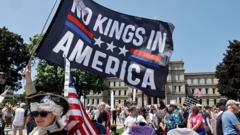Mass protests erupted across the United States as citizens rallied against President Trump's military parade held in Washington, D.C. This demonstration was organized by the grassroots movement "No Kings," responding to increasing discontent with Trump's immigration policies and governance style. Key cities including New York, Philadelphia, Los Angeles, and Houston saw significant gatherings where protesters expressed their opposition through speeches, signs, and the waving of American flags.
The military parade, coinciding with Trump's birthday, aimed to honor the 250th anniversary of the US Army. However, it simultaneously served as a flashpoint for tensions, as Trump cautioned that any demonstrations during the event would face "heavy force." Organizers claimed that protests reached hundreds of locations with millions of participants, underlining the growing frustration toward the administration.
In Philadelphia's Love Park, demonstrators like nurse Karen Van Trieste voiced their concerns, citing staffing cuts to public health agencies among their reasons for activism. In Los Angeles, which had seen a surge in protests over deportation actions, civil rights advocate Jose Azetcla criticized government policies separating families, stating, "It's not harsh, it's evil."
Although some protests turned confrontational, with incidents involving tear gas and National Guard soldiers, many participants marched peacefully, reflecting a broad spectrum of beliefs regarding Trump's controversial policies. Despite the protests, recent polls indicate that Trump’s immigration reform remains relatively popular, with a plurality supporting his efforts to deport illegal immigrants.
The name "No Kings" signifies the belief that Trump has overstepped the bounds of presidential authority during his second term. The parade itself featured thousands of active-duty soldiers, tanks, and military vehicles, with Trump delivering a brief address expressing gratitude for military service.
Critics, including former military officials, disparaged the event as a lavish showcase that could cost between $25 million to $45 million. However, some attendees defended it as an opportunity to honor the military. Veterans like Melvin Graves, who fought in Vietnam, saw the event as a long-overdue recognition of military service.
As the last US military parade occurred over three decades ago, the stark contrast of soldiers parading while military forces were deployed to counter demonstrations continued to fuel debates regarding the nation's political landscape. Despite the cancellation of some protests in Minnesota due to safety concerns around a recent tragedy, significant crowds still turned out, reflecting the urgency and passion of those opposing current policies.
This nationwide outcry highlights a moment of stark political polarization as the United States grapples with major issues surrounding immigration, executive power, and public perception of military involvement in civil affairs.


















